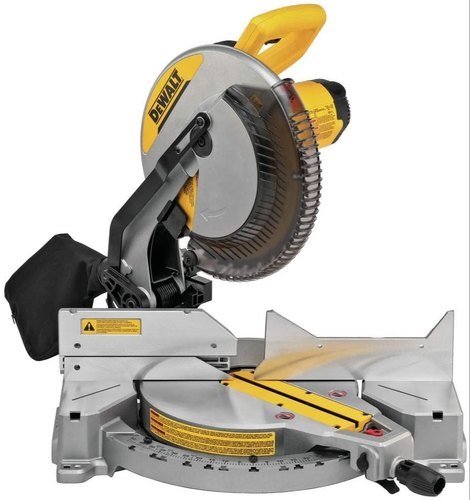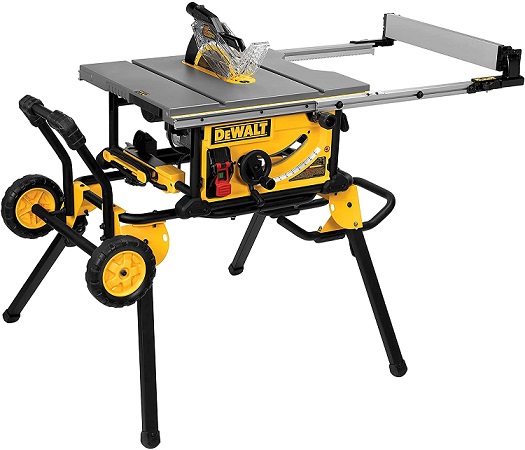They both look similar and often used for elementary tasks which is the reason why people often get confused these two options. However, they have some fundamental differences between them. Understanding them helps you make the right choice suitable for your requirements. In addition to that, it helps you use the right tool for the task. In this article, we are going to explore the key differences that distinguish miter saw and table saw. Read through the information to make a wise and informed decision.
Overview of Miter Saws
Scroll Saw Vs Jigsaw Types of Saws and Their Uses Router Vs Jigsaw Chop Saw vs Miter Saw Scroll Saw Vs Band Saw
A miter saw might initially look very similar to a table saw when you first see it. However, a miter saw’s blade faces up and is usually placed on top of a table. The miter saw is not the same as the table saw. The miter saw does not look like the table saw in that its blade is up and the tool cuts wood. A miter saw, unlike the table saws, isn’t designed to be attached to a table. It is a machine tool that you can place on the table. Its swing arm is the main feature of the miter saw. To make the desired cut, you can swing the arm up and down. Miter saws are extremely portable. The miter saw can be taken anywhere because it isn’t attached to a table. This type of saw can be used to quickly cut picture frames, door frames and other items.
Overview of Table Saws
A table saw is one the most commonly used tools. A table saw is a versatile tool that many homeowners and DIYers have. There are many options for table saws, including a tabletop model or a contractor’s version. It is an indispensable tool that can be used to do a wide range of woodworking tasks. The table saw is a common and versatile tool that woodworkers will use. It is often one of their largest purchases. There are several types of Table Saws such as benchtop saw, contractor’s saw, cabinet saw and a hybrid saw. Benchtop Saws are small and portable type table saw and are suitable for occasional woodworking for small to medium workloads. You can easily carry them with your by loading them onto your truck bed. Contractor’s Saw are slightly bigger than benchtop saws but are also portable in spite of their 250 – 300 lbs. weight. These saws have a large table that can handle most rip cut and crosscut jobs. If you are a professional woodworker, then you need a Cabinet Saw in your shop. As the name suggests, cabinet saws are completely enclosed that contain a large induction motor (anywhere between 3 and 7HP). A hybrid saw is a cross between the contractor’s saw and the cabinet saw, with a look and feel of a cabinet saw while the guts are similar to both the cabinet saw and the contractor’s saw.
Miter Saw Vs Table Saw – Comparison Table
Below is a quick comparison between table saw and miter saw. If you are in a hurry, this table helps you make the choice swiftly.
In-Depth Comparison of Table Saw and Miter Saw
Now, we shall go into the detail analysis of each factor for both the impact tools. Read the information thoroughly to make an informed decision.
1. Power
The table saw is more powerful than the miter saw because it is larger. Our experts recommend a table saw for larger pieces of timber and larger wood projects. If power is not your main concern, the smaller miter saw will be the better choice. It doesn’t hurt, depending on your work field, to have both a table saw and a miter saw in your workshop.
2. Dimensions of the Cuts
Because of its unique design, the table saw can be used to cut large pieces of wood. It allows you to feed the wood through the saw manually. A miter saw is the opposite. The user places a piece of wood on the base of the saw and then lowers its spinning blade to cut the material. These saws have similar blade sizes, but the more manual-intensive design allows for greater cuts on the table saw.
3. Cutting Angles
The miter saw is well-known for its ability to cut the most challenging angles with ease. A miter saw’s head can be rotated from one side to the other to make any angle possible. Because of their ability to cut complex angles for trimming trim, crown molding and other projects, miter saws are a common tool in trim carpentry. These angles can also be cut by a table saw, but it’s more difficult as the user must adjust their position and not just the blade. This is a tedious task that can quickly become tiring.
4. Length of the Cuts
A miter saw operates by dropping a spinning blade. It cannot make a cut longer than the blade’s width, which is usually only 8 to 12 inches. A sliding arm miter saw is the exception to this rule, but it can only cut as long as the arm. To cut longer pieces of material, you will need to lower the head several times. A table saw can, however, cut any length of the board as the blade is stationary and the wood is fed into it. As the wood is being fed, the cut pieces of the wood will fall to the sides.
5. The Width of the Saw Blade
Before you buy any power tool, make sure to evaluate their ability to cut woods in lengthwise. The width of the saw blade will determine the length that you can chop with a miter. A miter saw functions by lowering its circular blades spinning. It may not be able to make cuts longer than its blade’s length. There are three sizes of miter saws: the 12-inch, 10-inch and 8-inch models. For cutting larger pieces of wood, such as large crown moldings and siding planks, the blades with a wider width are necessary. The sliding compound miter saw is an exception to the blade width rule. It has gliding blades which can move on rails to make cuts up to 16 inches long. A table saw, on the other hand can cut the width of a board since the saw blade is stationary and the piece is fed into it.
6. Precision
The miter saw is the most precise of both. The material is held tightly against the miter saw’s back throughout the cut, so that it almost never moves while the blade is cutting it. Because the wood is always in motion, the table saw is exactly the opposite. The user can create slightly jagged edges on the board’s cut edge by changing the pressure. Although it won’t usually affect large projects, the slight imperfections that may occur with table saw cuts can cause a sloppy look when installing trim or other cuts that require more precision.
7. Safety and Ease of Operation
Power tools can be very dangerous. Safety instructions from the manufacturer should be followed when operating them. It is much more common for injuries to occur when using table saws. Kickback is a common cause of table saw injuries. The blade grabs onto the wood and pulls or throws the user’s hands into the blade. For beginners, table saws should not be used without attending a class or apprenticeship with an experienced woodworker. This is a great tool for beginners and miter saws are almost impossible to get knockback from. It is crucial to be careful when you move the blade side-to-side. This is how many injuries can occur when operating a miter saw.
8. Portability
Some table saws have wheels, but most are stationary. They are bolted to solid metal legs or are built into cabinets. Table saws are heavy and can be up to 300 lbs. They can also be difficult to transport with one person. The miter saws, which are basically the opposite, weigh in the 50-to-60-pound range. You can easily transport a miter saw around with ease because they are small and lightweight. The miter saw is an excellent tool for clearing out space in your workshop. With its larger base, the table saw is undoubtedly the bulkiest of all power saws.
9. Skill Level
A table saw can cut almost any type of cut that a miter saw can make. This is why your level of skill could also be a deciding factor. Our experts recommend a miter saw if you’re a beginner. But, it’s important to remember the purpose of your project and what you are trying to achieve.
10. Prices and Availability
Table saws are generally cheaper than miter saws. They can be purchased in hardware stores for around $100 to $200. You can expect to pay close to $1000 for the most expensive. Table saws that are less expensive will be around $200, but they become more valuable as the quality increases. You can get the most expensive models for as high as $2000. The most important thing is not the price, but the availability. You can find miter saws almost anywhere, and they are the most popular type of power saw available. The table saw is much rarer and it will not be easy to find one in your local hardware store if you need one larger.
Summary – Miter Saw or Table Saw
We’ve now covered the differences between these saws and what they do. Now it’s time for us to discuss which one we should buy. If you are looking to make straight, large cuts, a table saw is the best choice. However, a miter and bevel saws are better if you require precise cuts. Let’s take a closer look at the best times to get each saw. When to use a miter saw – General purpose cutting is best done with table saws, such as when you have to cut planks. Because they can perform long cuts quickly and accurately, table saws are the best choice. The table saw can easily cut through long beams and make straight crosscuts. When to use a table saw – If you are required to make many bevel and miter cuts, a miter saw is a good choice. A miter saw is the best tool for precise tasks such as furniture rails and edging. Technically, attachments can be purchased for a table saw to make miter cuts, but if you plan to use the tool frequently, you will need to purchase a miter-saw.
Final Takeaway –
When choosing between a table saw and a miter saw, there are many things to consider. A miter saw can be used to maneuver your saw around. A table saw is more suitable for cutting rips and crosscuts. You will find the best solution if it addresses your specific needs, the size of the projects you are working on, and the place where you work best. Please leave a comment below if you enjoyed this guide and found it helpful. If you have any questions, please leave a comment below. Comment * Name * Email * Website
Δ







![]()